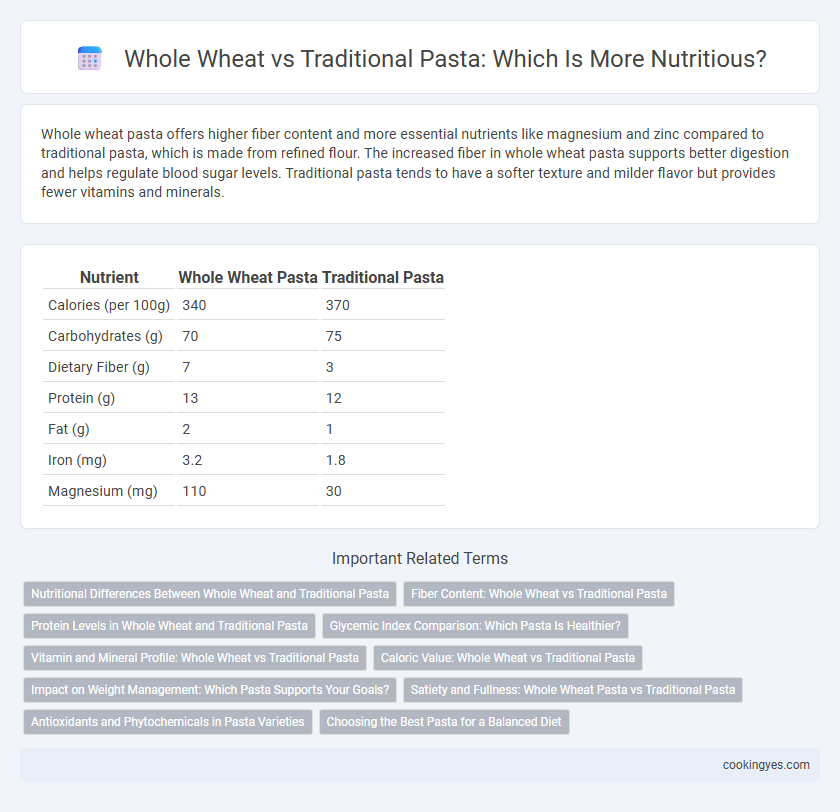Whole wheat pasta offers higher fiber content and more essential nutrients like magnesium and zinc compared to traditional pasta, which is made from refined flour. The increased fiber in whole wheat pasta supports better digestion and helps regulate blood sugar levels. Traditional pasta tends to have a softer texture and milder flavor but provides fewer vitamins and minerals.
Table of Comparison
| Nutrient | Whole Wheat Pasta | Traditional Pasta |
|---|---|---|
| Calories (per 100g) | 340 | 370 |
| Carbohydrates (g) | 70 | 75 |
| Dietary Fiber (g) | 7 | 3 |
| Protein (g) | 13 | 12 |
| Fat (g) | 2 | 1 |
| Iron (mg) | 3.2 | 1.8 |
| Magnesium (mg) | 110 | 30 |
Nutritional Differences Between Whole Wheat and Traditional Pasta
Whole wheat pasta contains higher levels of dietary fiber, protein, and essential minerals like magnesium and zinc compared to traditional pasta made from refined wheat flour. Traditional pasta typically has a higher glycemic index, causing quicker spikes in blood sugar levels, while whole wheat pasta offers better blood sugar control and increased satiety. These nutritional differences make whole wheat pasta a healthier option for managing weight and supporting digestive health.
Fiber Content: Whole Wheat vs Traditional Pasta
Whole wheat pasta contains significantly higher dietary fiber than traditional pasta, offering about 6 grams of fiber per cooked cup compared to 2 grams in refined pasta. The increased fiber content in whole wheat pasta promotes better digestion, helps regulate blood sugar levels, and supports heart health. Choosing whole wheat pasta can enhance daily fiber intake, contributing to improved overall nutritional quality in meals.
Protein Levels in Whole Wheat and Traditional Pasta
Whole wheat pasta contains approximately 7-8 grams of protein per 56-gram serving, compared to traditional pasta, which typically offers about 5-6 grams per the same serving size. The higher protein content in whole wheat pasta supports muscle repair and sustained energy levels more effectively than traditional pasta. Choosing whole wheat pasta can enhance the overall nutritional profile of meals by increasing dietary protein intake.
Glycemic Index Comparison: Which Pasta Is Healthier?
Whole wheat pasta has a significantly lower glycemic index (GI) compared to traditional pasta, typically ranging between 37-45 versus 50-60, which helps stabilize blood sugar levels and reduce insulin spikes. This lower GI value indicates whole wheat pasta can be a healthier choice for managing diabetes and supporting sustained energy release. Furthermore, whole wheat pasta contains more fiber and essential nutrients like magnesium and B vitamins, enhancing its overall nutritional profile beyond just glycemic control.
Vitamin and Mineral Profile: Whole Wheat vs Traditional Pasta
Whole wheat pasta offers a higher concentration of essential vitamins and minerals compared to traditional pasta, including increased levels of B vitamins such as niacin, thiamine, and folate, as well as minerals like iron, magnesium, and zinc. The bran and germ retained in whole wheat pasta contribute to its richer micronutrient profile, supporting better energy metabolism and immune function. In contrast, traditional pasta, typically made from refined flour, has reduced vitamin and mineral content due to processing that removes nutrient-dense components.
Caloric Value: Whole Wheat vs Traditional Pasta
Whole wheat pasta contains approximately 174 calories per 2-ounce serving, offering more fiber and protein compared to traditional pasta, which has about 200 calories for the same portion. The lower caloric value in whole wheat pasta supports better weight management and sustained energy release. Choosing whole wheat pasta enhances nutrient density while reducing calorie intake slightly, making it a healthier alternative to traditional refined pasta.
Impact on Weight Management: Which Pasta Supports Your Goals?
Whole wheat pasta contains higher fiber content and more protein than traditional pasta, promoting satiety and aiding in weight management by reducing overall calorie intake. The complex carbohydrates in whole wheat pasta provide a slower glycemic response, which helps maintain stable blood sugar levels and reduces cravings. Consequently, whole wheat pasta is often considered a better option for those aiming to support weight loss or maintain a healthy weight.
Satiety and Fullness: Whole Wheat Pasta vs Traditional Pasta
Whole wheat pasta contains higher dietary fiber, which slows digestion and enhances satiety compared to traditional pasta made from refined flour. The increased fiber content in whole wheat pasta promotes prolonged feelings of fullness, aiding in appetite control and weight management. Traditional pasta, lower in fiber, tends to digest quicker, leading to a shorter duration of fullness after meals.
Antioxidants and Phytochemicals in Pasta Varieties
Whole wheat pasta contains significantly higher levels of antioxidants and phytochemicals compared to traditional pasta made from refined wheat flour. These bioactive compounds, including phenolic acids and flavonoids, contribute to reduced oxidative stress and inflammation, promoting overall health. Choosing whole wheat pasta supports enhanced nutrient intake, aiding in the prevention of chronic diseases linked to oxidative damage.
Choosing the Best Pasta for a Balanced Diet
Whole wheat pasta offers higher fiber content, essential vitamins, and minerals compared to traditional pasta, aiding digestion and blood sugar control. Traditional pasta, made from refined flour, is lower in nutrients but often preferred for its texture and quicker cooking time. Opting for whole wheat pasta supports a balanced diet by promoting sustained energy release and improved satiety without sacrificing taste.
Whole wheat vs traditional pasta for nutrition Infographic

 cookingyes.com
cookingyes.com